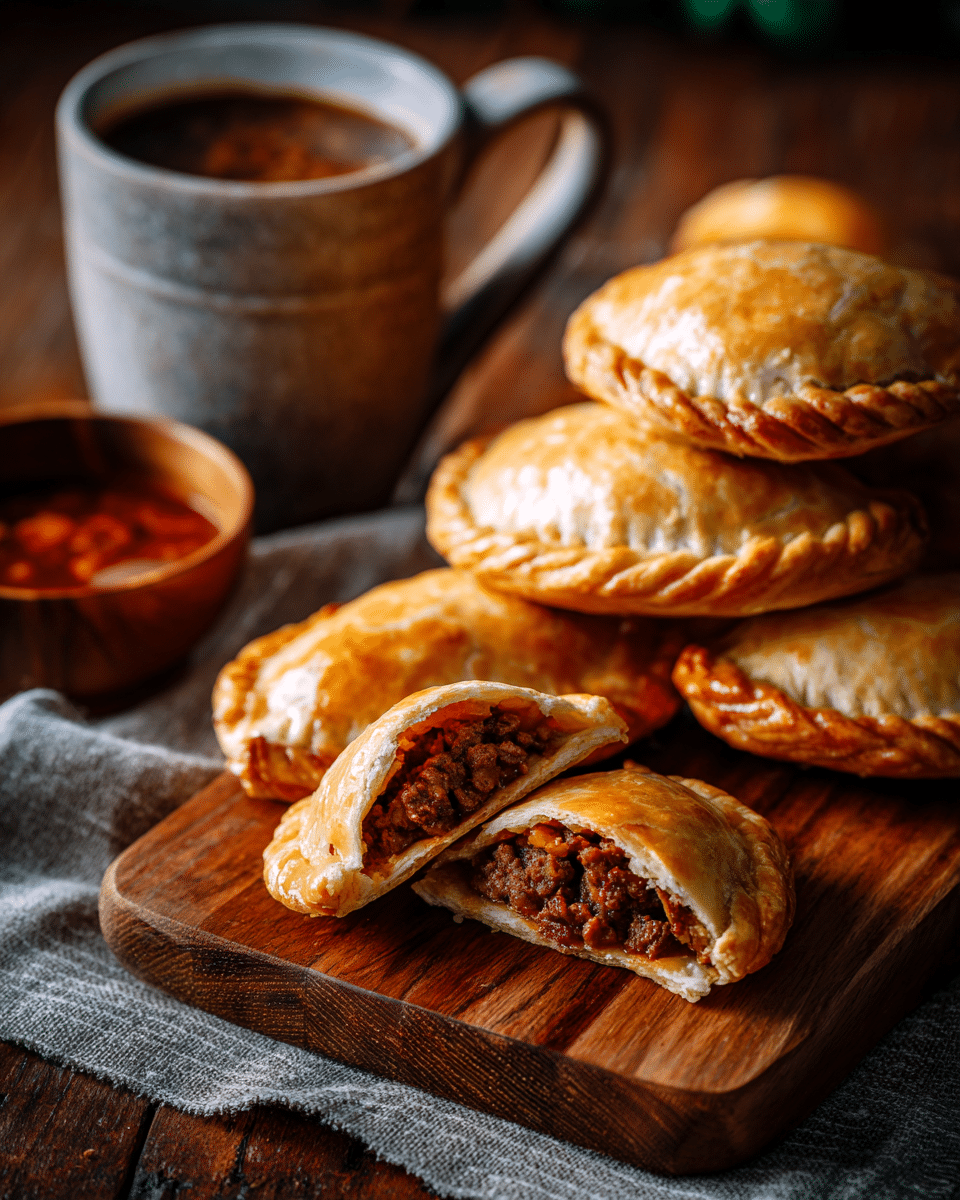Empanadas de Carne are a beloved Latin American snack featuring flaky, golden pastry pockets filled with a savory mixture of seasoned ground beef and vegetables. These handheld delights are perfect for parties, lunches, or casual dinners. Their crispy crust and rich, flavorful filling make them a favorite across many cultures, with variations found throughout South America and Spain.
FULL RECIPE
Ingredients
- 3 cups all-purpose flour
- 1 teaspoon salt
- 1/2 cup cold unsalted butter, cubed
- 1 egg
- 1/2 cup cold water (more if needed)
- 1 tablespoon white vinegar
- 1 tablespoon vegetable oil
- 1 pound ground beef
- 1 small onion, finely chopped
- 2 garlic cloves, minced
- 1/2 green bell pepper, finely chopped
- 1/2 cup tomatoes, diced
- 1/4 cup green olives, sliced
- 1 teaspoon ground cumin
- 1 teaspoon smoked paprika
- 1/2 teaspoon chili powder (optional)
- Salt and pepper, to taste
- 1 egg, beaten (for egg wash)
Directions
- In a large bowl, mix flour and salt. Cut in cold butter until mixture resembles coarse crumbs.
- In a separate bowl, whisk egg, water, vinegar, and vegetable oil. Gradually add to flour mixture, mixing until dough forms. Add more water if needed.
- Knead dough on a floured surface for 2-3 minutes until smooth. Wrap in plastic and refrigerate for at least 30 minutes.
- In a skillet over medium heat, cook ground beef until browned. Drain excess fat.
- Add onion, garlic, and bell pepper to beef; sauté until vegetables soften.
- Stir in tomatoes, olives, cumin, smoked paprika, chili powder (if using), salt, and pepper. Cook for 5-7 minutes until mixture thickens. Remove from heat and let cool.
- Preheat oven to 400°F (200°C).
- Roll out dough on a floured surface to about 1/8 inch thickness. Cut into 6-inch circles using a bowl or cutter.
- Place 2-3 tablespoons of filling in the center of each dough circle. Fold dough over to form a half-moon shape. Press edges with a fork to seal.
- Place empanadas on a baking sheet lined with parchment paper. Brush tops with beaten egg.
- Bake for 20-25 minutes or until golden brown and crisp.
- Serve warm with salsa or chimichurri sauce.
Nutrition Facts
- Calories: 280
- Total Fat: 15g
- Saturated Fat: 6g
- Cholesterol: 65mg
- Sodium: 350mg
- Total Carbohydrates: 22g
- Dietary Fiber: 2g
- Sugars: 2g
- Protein: 12g
- Iron: 2.1mg
- Calcium: 30mg
History and Origins of Empanadas de Carne
Empanadas de Carne have a rich history rooted in Spanish and Latin American culinary traditions. The name “empanada” comes from the Spanish verb “empanar,” meaning to wrap or coat in bread. These pastries were initially developed as a practical way to carry and preserve meat fillings for travelers and workers. Over time, empanadas evolved across Latin America, adapting to local ingredients and flavors, becoming beloved snacks or meals that reflect cultural identity and regional tastes.
The Importance of Dough Texture
The dough used for empanadas is key to their signature flaky texture. A good empanada dough strikes a balance between tenderness and sturdiness, allowing it to hold the filling without breaking while maintaining a crisp, golden crust. Using cold butter and handling the dough minimally prevents overworking gluten, which keeps the pastry light and flaky. Some variations use lard or shortening to further enhance flakiness and flavor.
Flavor Profile of the Beef Filling
The beef filling in empanadas de carne is typically savory and aromatic, blending ground meat with spices, herbs, and vegetables like onions, garlic, and bell peppers. Cumin and smoked paprika add warmth and depth, while ingredients like olives and tomatoes bring subtle tang and moisture. The balance of spices can be adjusted to personal preference, allowing for mild or more boldly seasoned fillings that satisfy a variety of palates.
Nutritional Aspects of Empanadas
Empanadas provide a satisfying mix of carbohydrates, protein, and fats, making them a balanced option when eaten in moderation. The beef filling offers high-quality protein and iron, essential for muscle health and energy. However, the pastry dough contributes carbohydrates and fats, including saturated fats from butter or lard. Those mindful of their diet can adjust ingredient quantities or opt for baking instead of frying to reduce calorie content.
Regional Variations Across Latin America
Empanadas come in countless regional varieties, reflecting local ingredients and cooking styles. In Argentina, for example, empanadas often include raisins, boiled eggs, or chili peppers. Chilean empanadas may feature a mix of beef, onions, olives, and hard-boiled eggs, while Colombian versions might incorporate potatoes or cornmeal dough. These differences celebrate cultural diversity and highlight the empanada’s adaptability.
Tips for Perfectly Sealed Empanadas
Sealing empanadas properly is crucial to prevent filling leakage during cooking. The traditional method uses a fork to crimp edges, creating a decorative seal. Some cooks create a twisted “repulgue” edge for added security and aesthetic appeal. Chilling the dough before shaping can make it easier to handle, and brushing edges with water or beaten egg helps the dough stick together firmly.
Serving Suggestions and Accompaniments
Empanadas de carne are versatile and pair well with a variety of sides and sauces. Popular accompaniments include chimichurri sauce, a tangy herb and garlic condiment, or simple salsas made from tomatoes and peppers. They also go well with fresh salads or pickled vegetables that add brightness and contrast. Empanadas can be served as appetizers, snacks, or part of a main meal depending on portion size.
Storage and Reheating Methods
Leftover empanadas can be stored in the refrigerator for up to three days and freeze well for longer preservation. To maintain crispiness, it’s best to reheat them in an oven or air fryer rather than a microwave. Gently warming empanadas at 350°F (175°C) for 10-15 minutes restores their flaky texture and ensures the filling is heated evenly without sogginess.
Making Empanadas Healthier
For a healthier version of empanadas, you can modify the dough by using whole wheat or alternative flours to increase fiber content. Baking instead of frying reduces fat intake, and leaner cuts of meat or plant-based proteins like lentils or mushrooms can be used in the filling. Reducing added salt and using fresh herbs enhances flavor without relying on extra sodium.
Advertisement
Empanadas in Modern Cuisine
Today, empanadas are enjoyed worldwide and have become a canvas for culinary creativity. Chefs experiment with fillings ranging from classic beef to fusion options like Thai chicken or vegan jackfruit. Their portability and satisfying nature make empanadas popular street food and catered items, demonstrating how traditional recipes continue to evolve while honoring their roots.
Conclusion
Empanadas de Carne are more than just a savory pastry; they are a testament to cultural heritage, culinary skill, and versatility. Their flaky crust and flavorful filling make them universally appealing, while their rich history and regional variations reflect diverse Latin American traditions.






